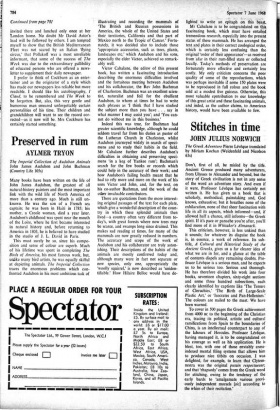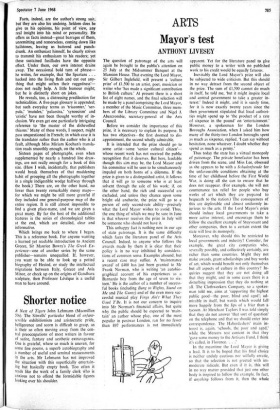Stitches in time
JOHN JULIUS NORWICH
The Greek Adventure Pierre L6vegue translated by Miriam Kochan (Weidenfeld and Nicolson 63s) Don't, first of all, be misled by the title. Ancient Greece produced many adventurers, from Ulysses to Alexander and beyond, but the story of Greek civilisation is not in any sense of the word an adventure story. And even if it were, Professor Leveque has certainly not written it. He has given us a book that is scholarly, methodical, painstaking and, God knows, exhaustive; but it breathes none of the exhilaration, none of that sheer fascination with life in all its aspects, which informed—and, if allowed half a chance, still informs—the Greek spirit. If it's pace or panache you're after, you'll find more of it in Whitaker's Almanack.
This criticism, however, is less unkind than it sounds; for whatever its disguise the book is, in essence, a work of reference. Its sub- title, A Cultural and Historical Study of the Ancient Greeks, gives us a far clearer idea of what we are in for, and a glance at the table of contents dispels any remaining doubts. Pro- fessor Ldvaque is a serious man, and he expects us to be serious too. Serious and thorough. He has therefore divided his work into four books, seventeen chapters, sixty-eight sections and some three hundred subsections, each clearly identified by captions like The Tenure of Cleruchies,"The Birth of Large-Scale Plastic Art,' or 'Isocrates and Pan-Hellenism.' The colours are nailed to the mast. We have been warned.
To cover in 500 pages the Greek achievement from 4000 BC to the beginning of the Christian era, tracing its political, artistic and cultural ramifications from Spain to the boundaries of China, is an intellectual counterpart to any of the labours of Hercules. Professor Lavague, having managed it, is to be congratulated on his courage as well as his application. He is blest, too, with one of those enviably cross- indexed mental filing systems that allows him to produce nice titbits on occasion. I was delighted, for example, to learn that Clytem- nestra was the original putain respectueuse; and that 'rhapsody' comes from the Greek word for stitching, owing to the tendency of the early bards to 'amalgamate various previ- ously independent morsels [sic] according to the whim of their recitation.' Facts, indeed, are the author's strong suit; tnit`they are also his undoing. -Seldom does he give us his opinions, his point of view, any real insight into his mind or personality. He offers us facts instead—great barrages of Them, unremitting and remorseless, coming down like hailstones, leaving us battered and punch- drunk. An enthusiast himself, he clearly strives to transmit his enthusiasm to his readers; yet these sustained fusillades have the opposite effect. Under them, our own interest drains away. The occasional bold turn of phrase— he writes, for example, that 'the Spartans . . . hacked into the living flesh and cut out any- thing that might soften their ruggedness'— does not really help. A little humour might; but he is distinctly short on jokes.
He reveals, too, a distressing predilection for technicalities. A five-page glossary is appended; but such everyday terms as `triaconter,"ser- pula,"mutules,"palaestra,"synoecism' and 'eristic' have not been thought worthy of in- clusion. We even get one particularly intriguing reference to 'the master of the dishevelled thiasus.' Many of these words, I suspect, might pass unquestioned in French; in which case it is the translator rather than the author who is at fault, although Miss Miriam Kochan's transla- tion reads smoothly enough, on the whole.
Sixteen pages of photographs, even when supplemented by nearly a hundred line draw- ings, are not really enough for a book of this size. (How I wish, incidentally, that publishers would break themselves of that maddening habit of grouping all the photographs together in a single indigestible wodge halfway through the book.) There are, on the other hand, no fewer than twenty remarkably messy maps— for which we might be still more grateful if they included one general-purpose map of the entire region. It is still almost impossible to find a given place-name, and we are given a great many. By far the best of the additional features is the series of chronological tables at the end, which are detailed, clear and informative.
Which brings me back to where I began. This is a reference book. For anyone wanting a learned yet readable introduction to Ancient Greece, Sir Maurice Bowra's The Greek Ex- perience—one of another series by the same publisher—remains unequalled. If, however, you want to be able to look up a potted biography of Hesiod, or study the intellectual migrations between Italy, Greece and Asia Minor, or check up on the origins of Gandhara sculpture, then Professor Leveque is a useful man to have around.







































 Previous page
Previous page